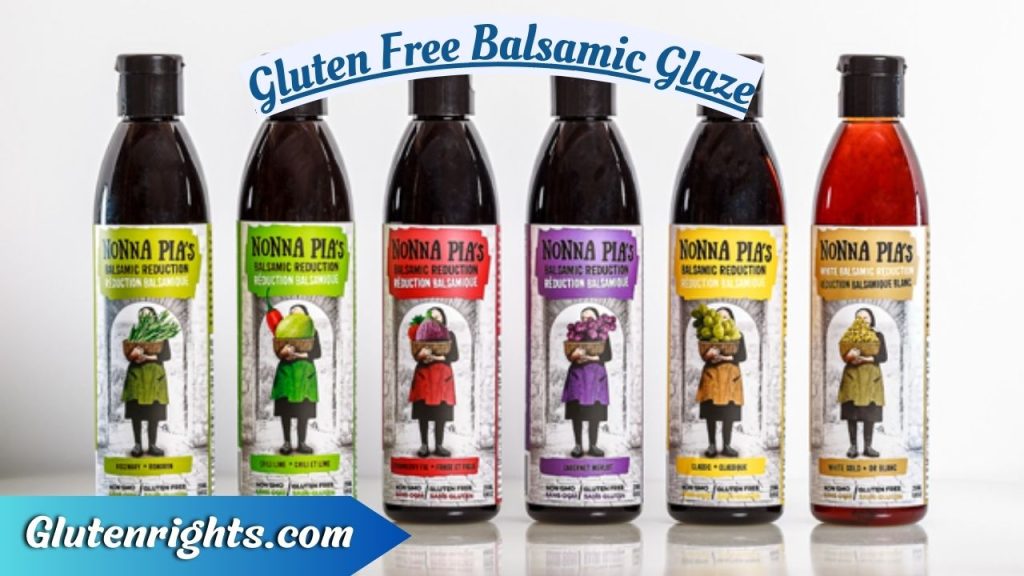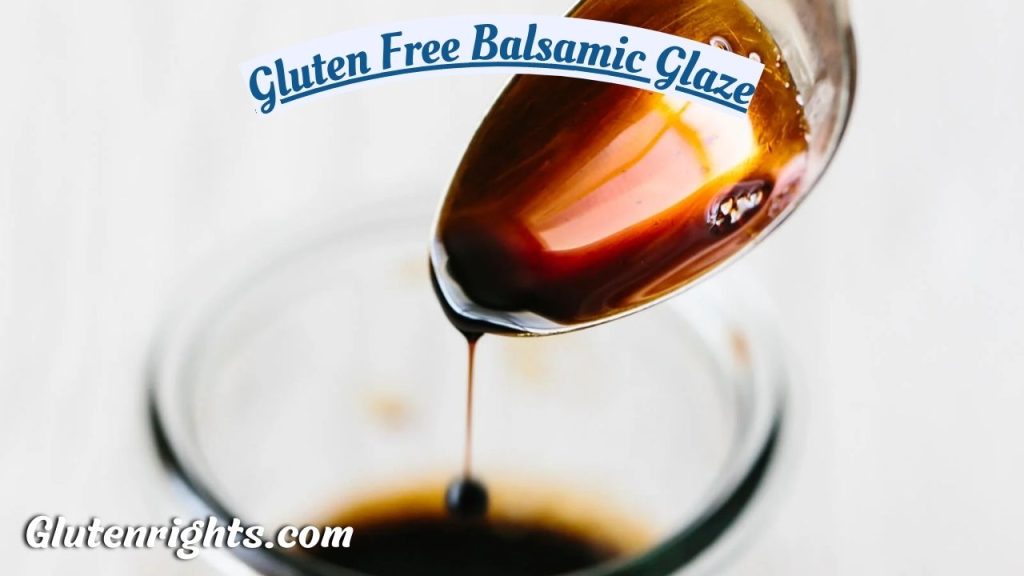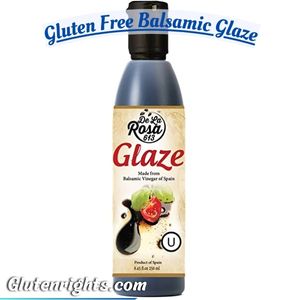It is a versatile ingredient that can add a burst of flavor to a wide variety of dishes. It’s perfect for drizzling over grilled meats, roasted vegetables, or even fresh fruit. Gluten Free Balsamic Glaze is free from gluten, making it an best choice for those with gluten sensitivities. The rich, tangy flavor of balsamic glaze is sure to impress even the most discerning palates.
Gluten-free balsamic reduction
Balsamic reduction is a sauce made by cooking balsamic vinegar until it reduces and concentrates in flavor. While balsamic vinegar itself is naturally gluten-free, it’s important to be aware that some brands of balsamic vinegar may contain added ingredients that contain gluten.
For those who are sensitive to gluten or have celiac disease, it’s crucial to check the label and choose a gluten-free balsamic vinegar for the reduction. Some brands of balsamic reduction contain gluten-containing additives or thickeners, so it’s important to check the label many times before purchasing or consuming any pre-made balsamic reduction.
To make a gluten-free balsamic reduction at home, it’s important to start with a gluten-free balsamic vinegar. The best way to ensure that the vinegar is gluten-free is to look for a certified gluten-free label on the bottle or to contact the manufacturer directly.

Once you have a safe balsamic vinegar, simply pour it into a saucepan and heat it over medium heat until it starts to boil. After this reduce the heat and let it simmer, stirring occasionally, until it thickens and reduces about half.
This procedure take anywhere from 20 to 40 minutes depending on the amount of vinegar and the desired consistency of the reduction. Once it’s thick enough to coat the back of a spoon, it is ready to use.
Sweet and tangy balsamic glaze
It has sweet and tangy flavor profile makes it a popular choice for variety of recipes. Made from balsamic vinegar, the glaze is reduced until it thickens, intensifying its flavor. The resulting glaze can be drizzled over salads, roasted vegetables, meats, or even used as a dipping sauce for bread.
The sweetness of balsamic glaze comes from the natural sugars in the balsamic vinegar, which are concentrated during the reduction process. This sweetness is balanced by the tangy acidity of the vinegar, creating a complex and delicious flavor profile. Balsamic glaze has a syrupy texture, which adds luxury touch to dish.
It can be used as a finishing touch on dishes like grilled meats or roasted vegetables to give them a beautiful glossy finish. Making balsamic glaze is easy and it can be customized to suit individual tastes.
Some recipes call for the addition of sugar, honey or other sweeteners to enhance the sweetness of the glaze. Others may add spices like garlic or herbs like thyme to give it a unique flavor profile. Balsamic glaze is also a great way to use up any leftover balsamic vinegar that may be sitting in the pantry
Easy gluten-free balsamic syrup
Balsamic syrup is a delicious addition to various dishes, but it can be challenging to find a gluten-free version in stores. Luckily, making your own gluten-free balsamic syrup at home is easy and only requires a few simple ingredients. To start, you’ll need balsamic vinegar, sugar, and a saucepan.
To make gluten-free balsamic syrup, start by combining equal parts balsamic vinegar and sugar in a saucepan over medium heat. Stir the mixture until the sugar has completely dissolved.
Reduce the heat to low flame and allow the mixture to simmer for 15-20 minutes, or until it has thickened and reduced by half. Be sure to stir many times to prevent the mixture from burning.
Once your gluten-free balsamic syrup has reduced and thickened, remove it from the heat and allow it to cool before using. You can use it as a drizzle over roasted vegetables, grilled meats, or even as a topping for ice cream or fresh fruit. Store the left syrup in an airtight container in the refrigerator for up to a week.
Homemade balsamic drizzle without gluten
Balsamic drizzle is a versatile and tasty addition to any dish. It gives a tangy sweetness that pairs well with savory and sweet flavors. Many store-bought balsamic drizzles contain gluten, making them unsuitable for those with gluten sensitivity.
The good news is that you can easily make gluten-free balsamic drizzle at home with just a few simple ingredients. To make homemade gluten-free balsamic drizzle, you will need balsamic vinegar, honey, and cornstarch. Start by whisking together the balsamic vinegar and honey in the saucepan over normal heat.
Once the mixture begins to simmer, whisk in the cornstarch to thicken the mixture. Continue to cook the mixture, stirring frequently until it has reduced by half and has a syrupy consistency. Let the drizzle cool before transferring it to a squeeze bottle or jar for easy storage.
The best thing about making your own balsamic drizzle is that you can customize the flavor to suit your taste. If you like a sweeter drizzle, add more honey. If you prefer a more tangy flavor, use less honey and more balsamic vinegar.
You can also experiment with different types of vinegar, such as red wine vinegar or apple cider vinegar, to create unique flavors. Once you have mastered the basic recipe, feel free to get creative and add your own twist to this tasty condiment.
Gluten-free balsamic vinegar reduction
Balsamic vinegar is a common ingredient in many dishes, but it contains gluten which can be problematic for people with celiac disease or gluten sensitivity. Fortunately, you can easily make a gluten-free balsamic vinegar reduction by using a gluten-free balsamic vinegar.
To make the reduction, simply heat the vinegar in saucepan until it thickens and becomes syrupy. This gluten-free balsamic vinegar reduction is perfect for adding flavor to salads, roasted vegetables, and grilled meats.
When making a gluten-free balsamic vinegar reduction, it is important to choose a balsamic vinegar that is labeled as gluten-free. This will conform that there are no hidden sources of gluten in the vinegar. You can also check the ingredient list on the label to ensure that there are no gluten-containing ingredients.
Once you have a gluten-free balsamic vinegar, simply heat it in a saucepan over medium-high heat until it thickens and becomes syrupy.
Thick and glossy Gluten Free Balsamic Glaze
Balsamic glaze is a thick and glossy sauce that is a must-have ingredient in every kitchen. It’s formed by reducing balsamic vinegar until it thickens and becomes syrupy. This process enhances its flavor and produces a sweet and tangy taste that complements both savory and sweet dishes.
The glaze is thick and glossy, which makes it best for drizzling over salads, roasted vegetables, grilled meats and even desserts. The glaze can be bought pre-made from the store or made from scratch in the comfort of your own kitchen.
The versatility of balsamic glaze is what makes it a popular ingredient among chefs and home cooks alike. Its thick and glossy texture can be used to add depth of flavor and a sophisticated touch to any dish.
Also check: Gluten Free Jaffa Cakes

It is a great addition to marinades, sauces, and dressings, and can be used as a finishing touch to elevate the presentation of a dish. The sweetness of the glaze is balanced with its acidity, which makes it a perfect accompaniment to cheese boards and charcuterie platters.
Gluten Free Balsamic Glaze reduction for salads
A Gluten Free Balsamic Glaze reduction is a great addition to any salad for those who are avoiding gluten in their diets. To make a gluten-free balsamic reduction, start by combining balsamic vinegar and honey in a small saucepan over medium heat.
Stir the mixture until it comes to a simmer, then reduce the heat to low and let it cook for about 15 minutes until it has thickened. Remove from heat and let it cool before serving over your favorite salad. This gluten-free balsamic reduction is perfect for adding a tangy and sweet flavor to your salad without the gluten.
Another option for a gluten-free balsamic reduction is to use maple syrup instead of honey. Maple syrup is a great alternative to honey for those who are vegan or prefer a different taste. To make this version of a gluten-free balsamic reduction, combine balsamic vinegar and maple syrup in a small saucepan over medium heat.
Stir until the mixture comes to simmer, then reduce the heat to low flame and let it cook for about 8 minutes until it has thickened. This version of the gluten-free balsamic reduction has a different flavor and is perfect for adding to salads.
Quick gluten-free balsamic sauce
Gluten-free balsamic sauce is a versatile and flavorful addition to any dish. To make a quick and easy gluten-free balsamic sauce, start by heating a small amount of olive oil in a saucepan over medium heat. Once the oil is hot, add minced garlic and cook for 2 minute or 3 until fragrant.
Next, add balsamic vinegar, honey and a little bit salt and pepper to the pan. Stir everything together and let it simmer for a 5 minutes until the sauce has thickened slightly. This sauce is best for drizzling over grilled vegetables or as a dipping sauce for gluten-free bread.
Another option for a delicious gluten-free balsamic sauce is to use a combination of balsamic vinegar, olive oil, and Dijon mustard. Start by whisking together the vinegar and mustard in a small bowl. Slowly drizzle in the olive oil while continuing to whisk until the mixture has emulsified. Season the sauce with salt and pepper to taste.
This sauce is great for marinating chicken or pork or as a dressing for a gluten-free salad. For a creamy gluten-free balsamic sauce, start by melting butter in a saucepan over medium heat. Add minced shallots and cook until they are soft and translucent.
Next, add balsamic vinegar, heavy cream, and a little bit salt and pepper to the pan. Let the mixture simmer for a few minutes until it has thickened slightly. This sauce is perfect for serving over gluten-free pasta or as a topping for grilled steak or chicken.
Healthy Gluten Free Balsamic Glaze
Balsamic glaze is versatile condiment that can add a burst of flavor to any dish. For those who are gluten-free, finding a healthy Gluten Free Balsamic Glaze can be a bit of a challenge. However, with a few simple substitutions, it’s possible to make a delicious glaze that is both gluten-free and healthy.
One of the key ingredients in balsamic glaze is vinegar, and luckily, most types of vinegar are naturally gluten-free. Balsamic vinegar, in particular, is a great choice for a gluten-free glaze as it has a rich, complex flavor that pairs well with a variety of foods.
To make a Gluten Free Balsamic Glaze, simply mix balsamic vinegar with a touch of honey or maple syrup and reduce it down until it becomes thick and syrupy. When making a healthy gluten-free balsamic glaze, it’s important to be mindful of the ingredients you use.
For example, many store-bought glazes contain added sugars or preservatives, which can be detrimental to your health. Instead, try making your own glaze using all-natural ingredients. In addition to balsamic vinegar and sweetener, you can also add other flavorful ingredients such as garlic, herbs, or spices.
Delicious gluten-free balsamic reduction for chicken
Balsamic reduction is a simple yet elegant way to elevate the flavor of chicken, and with a few easy substitutions, it can be made gluten-free. To start, choose a high-quality balsamic vinegar that is gluten-free, which should be clearly labeled on the bottle. In a small saucepan, bring the balsamic vinegar to a simmer and let it reduce by half, stirring after some time.
Once it has thickened remove from the heat and let it cool slightly. Drizzle the balsamic reduction over cooked chicken breasts for a sweet and tangy finishing touch that will have your taste buds singing. To make a more complex and flavorful gluten-free balsamic reduction for chicken, try adding in some herbs and spices.
For example, a sprig of rosemary or thyme can infuse the reduction with an earthy aroma and a subtle hint of freshness. Alternatively, a pinch of black pepper or red pepper flakes can add some heat and complexity to the sauce. Experiment with different combinations of herbs and spices to find the perfect balance for your taste buds.
Amazing gluten-free balsamic reduction for steak
A delicious gluten-free balsamic reduction can take your steak to the next level. To start, choose a high-quality balsamic vinegar that is gluten-free, which should be clearly labeled on the bottle. In a saucepan, bring the balsamic vinegar to a simmer and let it reduce by half, stirring occasionally.
Once it has become syrupy, remove from the heat and let it cool slightly. Drizzle the balsamic reduction over cooked steak for a sweet and tangy finishing touch that will have your taste buds singing.
For a more complex flavor, try adding some garlic or shallots to the reduction. Simply sauté the minced garlic or shallots in a bit of olive oil before adding the balsamic vinegar to the saucepan. Let the reduction simmer and thicken as usual, stirring occasionally.
The garlic or shallots will infuse the reduction with a savory, slightly sweet flavor that complements the steak perfectly. For a truly decadent gluten-free balsamic reduction, add a pat of butter to the saucepan before removing it from the heat. The butter will melt and combine with the balsamic reduction, creating a rich and indulgent sauce that is perfect for steak.
FAQS
What brands of balsamic vinegar are gluten-free?
There are several brands of balsamic vinegar that are gluten-free. One such brand is Colavita Balsamic Vinegar of Modena. Another brand that offers gluten-free balsamic vinegar is Pompeian Gourmet Organic Balsamic Vinegar. Lucini Italia Organic Balsamic Vinegar of Modena is another gluten-free option.
Is all balsamic dressing gluten-free?
No, not all balsamic dressings are gluten-free. While balsamic vinegar itself is gluten-free, some brands of balsamic dressings may contain gluten-containing additives such as thickeners or flavorings.
Is balsamic glaze gluten and dairy free?
Balsamic glaze is typically gluten-free and dairy-free, as it’s made from balsamic vinegar and sugar that are cooked down to a syrupy consistency.
Is glaze gluten-free?
Glaze can be gluten-free or not, depending on its ingredients. Traditional glaze recipes may contain wheat flour, which contains gluten. There are gluten-free alternatives available, such as rice flour, cornstarch, or potato starch.
Is balsamic vinegar is halal?
Balsamic vinegar is generally considered halal as it’s made from grape must and does not contain any alcohol or animal-derived ingredients.
Is Basmati vinegar gluten-free?
There is no such thing as Basmati vinegar. Basmati is a type of long-grain rice that is commonly used to make dishes like biryani and pilaf. Vinegar, on the other hand, is a fermented liquid made from various ingredients such as grapes, apples, and rice.
